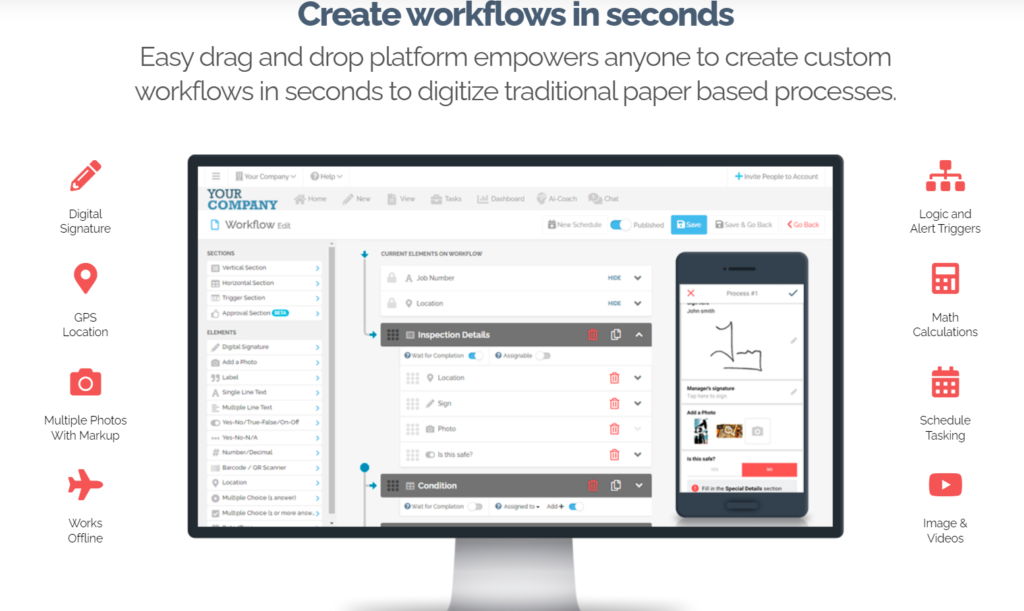In today’s fast-paced industrial landscape, the role of inspection personnel is more critical than ever. Ensuring that these professionals are continuously trained is not just a matter of compliance but a strategic necessity. Continuous training enhances their skills, keeps them updated with the latest industry standards, and ultimately ensures the safety and efficiency of operations.
This article delves into the importance of continuous training for inspection personnel and how digital solutions like FAT FINGER can streamline this process. Request a demo today to see how FAT FINGER can revolutionize your training and inspection workflows.
The Role of Inspection Personnel
Inspection personnel are the backbone of quality assurance in various industries, including manufacturing, construction, and healthcare. Their primary responsibilities include:
- Ensuring compliance with industry standards and regulations
- Identifying defects and areas for improvement
- Maintaining safety protocols
- Documenting and reporting findings
Given these critical tasks, the need for continuous training becomes evident. Without it, the risk of errors, non-compliance, and safety hazards increases significantly.
Why Continuous Training is Essential
Continuous training is not just a buzzword; it is a necessity for maintaining high standards in inspection processes. Here are some compelling reasons why continuous training is essential:
Keeping Up with Technological Advancements
Technology is evolving at a rapid pace. New tools and software are constantly being introduced to make inspection processes more efficient. Continuous training ensures that inspection personnel are proficient in using these new technologies, thereby improving their productivity and accuracy.

Adapting to Regulatory Changes
Regulations and industry standards are subject to change. Continuous training helps inspection personnel stay updated with these changes, ensuring that their work remains compliant. This is particularly important in industries like healthcare and construction, where non-compliance can have severe consequences.
Enhancing Skill Sets
Continuous training provides opportunities for inspection personnel to enhance their skill sets. This not only makes them more competent in their current roles but also prepares them for future career advancements. For example, training in advanced inspection techniques or new software tools can open up new career opportunities.
Improving Safety and Efficiency
Well-trained inspection personnel are more likely to identify potential safety hazards and areas for improvement. This leads to a safer work environment and more efficient operations. Continuous training ensures that they are always at the top of their game, minimizing the risk of accidents and inefficiencies.
Case Studies: The Impact of Continuous Training
To illustrate the importance of continuous training, let’s look at a real-world example in the manufacturing industry:
Manufacturing Industry
A leading manufacturing company implemented a continuous training program for its inspection personnel. The program included regular workshops, online courses, and hands-on training sessions. As a result, the company saw a 30% reduction in defects and a 20% increase in overall productivity. The continuous training program also helped the company stay compliant with new industry standards, avoiding costly fines and penalties.
The Role of Digital Solutions in Continuous Training

While the importance of continuous training is clear, implementing it can be challenging. This is where digital solutions like FAT FINGER come into play. FAT FINGER offers a comprehensive platform for managing training and inspection workflows, making the process more efficient and effective.
Streamlining Training Programs
FAT FINGER allows organizations to create and manage training programs with ease. The platform supports various training formats, including online courses, video tutorials, and interactive quizzes. This flexibility ensures that inspection personnel can access training materials anytime, anywhere, making continuous learning more accessible.
Tracking Progress and Performance
One of the key features of FAT FINGER is its ability to track the progress and performance of inspection personnel. The platform provides detailed analytics and reports, allowing managers to identify areas where additional training is needed. This data-driven approach ensures that training programs are tailored to meet the specific needs of each individual.
Ensuring Compliance
FAT FINGER helps organizations stay compliant with industry standards and regulations. The platform includes built-in compliance checklists and audit trails, making it easier to document and report compliance activities. This not only reduces the risk of non-compliance but also simplifies the audit process.
Enhancing Collaboration
FAT FINGER fosters collaboration among inspection personnel by providing a centralized platform for sharing knowledge and best practices. The platform includes features like discussion forums, document sharing, and real-time notifications, making it easier for teams to stay connected and informed.
Conclusion
Continuous training is essential for maintaining high standards in inspection processes. It ensures that inspection personnel are proficient in the latest technologies, compliant with regulatory changes, and equipped with the skills needed to perform their roles effectively. Digital solutions like FAT FINGER make it easier to implement and manage continuous training programs, ultimately leading to safer and more efficient operations.
Don’t wait to enhance your inspection processes. Create a mobile asset inspection workflow for free on FAT FINGER or request a demo today to see how our platform can revolutionize your training and inspection workflows.

